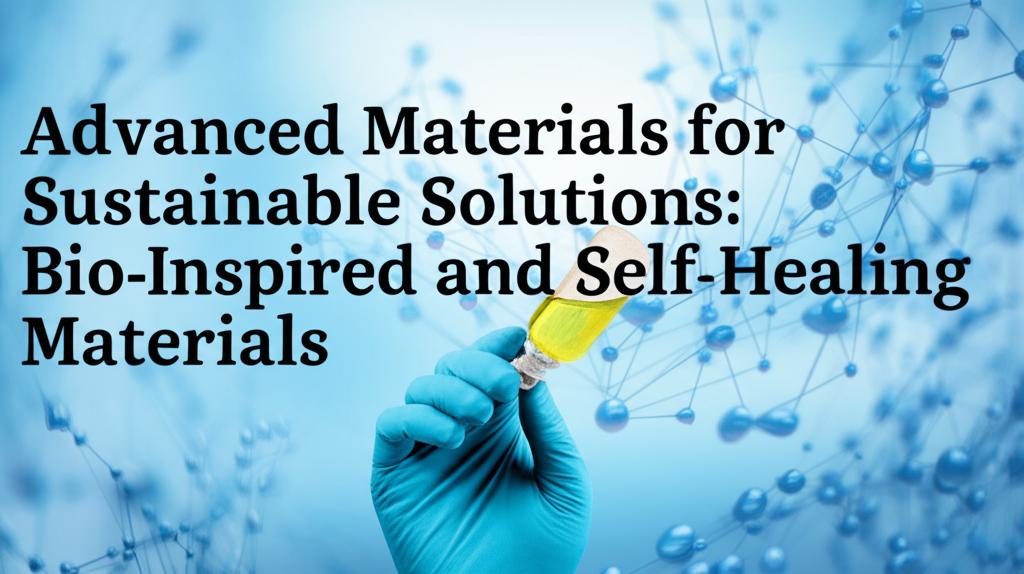The pursuit of sustainable solutions has driven significant innovation in material science, with bio-inspired and self-healing materials emerging as particularly promising fields. These advanced materials offer the potential to reduce waste, conserve resources, and create more durable and efficient products.
Bio-Inspired Materials: Learning from NatureNature has perfected materials and processes over millennia, offering a rich source of inspiration for scientists and engineers. Bio-inspired materials aim to mimic these natural designs and functionalities to create sustainable solutions.
A key area of development is the creation of materials based on natural building blocks and self-assembly processes. For instance, researchers are exploring how the hierarchical structures found in wood or the unique properties of spider silk can be replicated to produce advanced materials with exceptional strength-to-weight ratios or elasticity. By understanding and harnessing biomolecular interactions, scientists can design hybrid bionanomaterials incorporating nanoparticles, carbon nanotubes, or graphene, leading to novel structures with tailored properties.
Applications of bio-inspired materials are diverse and expanding. They range from developing new sensors that change color in response to stimuli, much like a chameleon's skin, to creating building materials that can help mitigate climate change by sequestering carbon or adapting to extreme environmental conditions. In the realm of manufacturing, bio-inspired design is leading to more efficient processes, such as the production of artificial spider silk using yeast fermentation, which offers a sustainable alternative to petroleum-based synthetic fibers. additive manufacturing, or 3D printing, inspired by natural structures like balsa wood's honeycomb arrangement, allows for the creation of lightweight, high-strength components for industries like aerospace and automotive, minimizing material waste and energy consumption.
Self-Healing Materials: Designing for Durability and LongevitySelf-healing materials possess the remarkable ability to autonomously repair damage, thereby extending their lifespan and reducing the need for replacements. This field draws inspiration from the regenerative capabilities of biological systems, like skin healing a wound or bone mending a fracture.
There are two primary approaches to self-healing materials: intrinsic and extrinsic.
- Intrinsic self-healing relies on the inherent properties of the material, often involving reversible chemical bonds that can break and reform in response to damage. These materials can often heal the same spot multiple times.
- Extrinsic self-healing involves incorporating healing agents, such as microcapsules or vascular networks, within the material. When damage occurs, these agents are released to fill and repair the affected area.
Significant progress is being made in developing self-healing polymers, composites, concrete, and coatings. For example, self-healing concrete, which can utilize embedded bacteria or expansive mineral admixtures to repair cracks, holds great promise for more durable and sustainable infrastructure. In electronics, self-healing materials could lead to longer-lasting devices that can repair minor damages like scratches or circuit breaks. Recent breakthroughs include multilayered self-healing films using organosiloxane and polydimethylsiloxane (PDMS), which exhibit enhanced rigidity, stability, and thermal resistance, making them suitable for durable, maintenance-free coatings in electronics, aerospace, and optics.
Synergies and ApplicationsThe intersection of bio-inspired design and self-healing capabilities offers exciting possibilities. For instance, materials could be designed to not only mimic natural structures but also to incorporate self-repair mechanisms inspired by biological healing processes. This could lead to highly resilient and adaptive materials for a wide range of applications.
Advanced materials, including bio-inspired and self-healing types, are finding applications across numerous sectors:
- Construction: Self-healing concrete, sustainable building materials derived from renewable resources, and materials that improve energy efficiency.
- Manufacturing: Lighter, stronger components, reduced material waste through additive manufacturing, and products with extended lifecycles.
- Energy: Materials for rechargeable batteries, solar cells, photocatalysis, hydrogen production, and energy-efficient lighting (LEDs, OLEDs).
- Electronics: Flexible and wearable devices with self-repair capabilities, and more durable electronic components.
- Healthcare: Biocompatible materials for implants and prosthetics, tissue engineering scaffolds, and drug delivery systems.
- Automotive and Aerospace: Lightweight composites, scratch-healing coatings, and components designed for enhanced durability.
Despite significant advancements, challenges remain in the widespread adoption of these advanced materials. These include:
- Scalability and Cost: Transitioning from laboratory-scale production to cost-effective mass manufacturing is a key hurdle.
- Durability and Performance: Ensuring that self-healing capabilities do not compromise other essential material properties like strength or stiffness, and maintaining long-term functionality of healed regions, remain areas of active research.
- Complexity of Natural Systems: Fully understanding and effectively mimicking the intricacies of biological systems is a continuous challenge.
- Integration: Seamlessly integrating these new materials into existing manufacturing processes and products requires further development.
- Lifecycle Assessment: A comprehensive understanding of the environmental impact of these materials throughout their entire lifecycle, from raw material extraction to disposal or recycling, is crucial.
The future of advanced materials for sustainable solutions is bright. Ongoing research focuses on developing multifunctional materials, enhancing healing efficiency, exploring new bio-inspired designs, and leveraging tools like machine learning and AI for material discovery and design. Interdisciplinary collaboration between material scientists, biologists, engineers, and industry partners will be crucial to accelerate the translation of these innovative materials from the lab to real-world applications. As these technologies mature, they hold the potential to revolutionize industries, significantly reduce our environmental footprint, and contribute to a more sustainable and circular economy.

